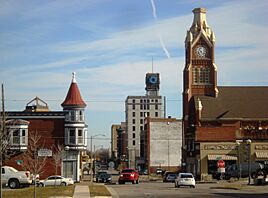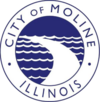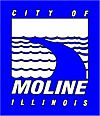Moline, Illinois facts for kids
Quick facts for kids
Moline, Illinois
|
|||||
|---|---|---|---|---|---|
|
John Deere World Headquarters
Bass Street Landing
|
|||||
|
|||||
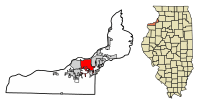
Location of Moline in Rock Island County, Illinois.
|
|||||
| Country | United States | ||||
| State | Illinois | ||||
| County | Rock Island County | ||||
| Incorporated | 1848 | ||||
| Area | |||||
| • City | 16.92 sq mi (43.83 km2) | ||||
| • Land | 16.75 sq mi (43.39 km2) | ||||
| • Water | 0.17 sq mi (0.44 km2) | ||||
| Population
(2020)
|
|||||
| • City | 42,985 | ||||
| • Density | 2,565.81/sq mi (990.64/km2) | ||||
| • Metro | 381,342 (134th) | ||||
| Time zone | UTC−6 (CST) | ||||
| • Summer (DST) | UTC−5 (CDT) | ||||
| ZIP code |
61265
|
||||
| Area code(s) | 309 | ||||
| FIPS code | 17-49867 | ||||
Moline (/moʊˈliːn/ moh-LEEN) is a city in Rock Island County, Illinois, United States. In 2020, its population was 42,985, making it the largest city in Rock Island County. Moline is part of the Quad Cities, a group of cities located where the Rock and Mississippi rivers meet. The other cities are East Moline and Rock Island in Illinois, and Davenport and Bettendorf in Iowa. The Quad Cities area had about 380,000 people in 2023. Moline is the ninth-largest city in Illinois outside of the Chicago metropolitan area.
Moline was founded in 1843. Its name comes from the French word moulin, which means "mill town". The main office of Deere & Company, a famous farm equipment company, is in Moline. Kone, an elevator company, also has its U.S. headquarters here. You can find the Quad City International Airport, Black Hawk College, and the Quad Cities campus of Western Illinois University-Quad Cities in Moline. It's also a big shopping area for the Illinois Quad Cities, with South Park Mall and many other stores. Downtown Moline is a lively place for events, with the 12,000-seat Vibrant Arena at The MARK and John Deere Commons.
Contents
- Discovering Moline's Past: A City's Journey
- Exploring Moline's Location and Layout
- Moline's Population and People
- Moline's Economy: Major Employers
- Arts and Culture in Moline
- Sports and Recreation in Moline
- Learning in Moline: Schools and Colleges
- Moline in the Media
- Getting Around Moline: Transportation
- Famous People from Moline
- See also
Discovering Moline's Past: A City's Journey
Early Beginnings: From Native Lands to Mill Town (Before 1848)
Long ago, Indigenous peoples lived along the rivers in this area. The Sauk and Meskwaki tribes built a village called Saukenuk in 1720 near the Rock and Mississippi rivers. They found the land great for farming and fishing.
In the early 1800s, more European-American settlers arrived. This led to conflicts, including the Black Hawk War in 1832. After the war, the Native American tribes had to leave, opening the way for more settlers.
In 1837, David B. Sears and his partners built a dam across Sylvan Slough. This dam connected the mainland to Arsenal Island and provided water power for a mill. Many factories soon appeared along the river. In 1843, a factory town was planned. Charles Atkinson, a major landowner, chose the name Moline, which means "City of Mills" in French. Moline officially became a town on April 21, 1848.
That same year, John Deere, who invented the self-cleaning steel plow, moved his company to Moline. Even though Moline was small, Deere saw its potential. The dam and coal deposits offered power, it was near other towns like Rock Island and Davenport, and the river allowed for easy shipping. As Deere's factories grew, Moline grew too.
The first transcontinental railroad reached Moline in 1854. It brought many immigrants, mostly from Sweden, Belgium, and Germany, who were looking for work. The railroad connected Moline to the rest of the country, helping the city succeed.
Moline's early leaders were hard-working people from New England. They wanted Moline to be a serious, industrial city, like Lowell, Massachusetts. They focused on industry, not parks, along the river. Moline attracted many Swedish immigrants, known for their strong work ethic.
As Moline and Rock Island grew, they almost merged. However, they couldn't agree on which city would be in charge or how to handle debts. Moline was also strongly Republican, while Rock Island had many Southerners who supported the Confederate cause during the Civil War. So, the cities remained separate.
Growth and Change: From 1860s to 1940s
After the Civil War, Moline continued to grow. More housing was needed, and the city expanded. People in Moline had a good quality of life. Many workers saved their money to buy homes instead of spending it on entertainment.
John Deere expanded his company to make other farm equipment, and many Moline residents worked for him. Other companies also became famous, including those making pipe organs and furniture. Early car companies like Moline Automobile Company and Velie Motors Corporation also started here.
By 1890, Moline had 12,000 residents. New technologies improved the city. Electricity arrived in 1881, and an electric streetcar system soon connected Moline with Rock Island and Davenport. This allowed people to live in one city and work or shop in another. Moline's streetcar system was one of the best in Illinois. The city also developed the state's first garbage collection system in 1894.
New public buildings were built, including the first public library in 1873 and Moline Public Hospital in 1896.
In 1872, Moline changed its government to a mayor/alderman system. John Deere lost the first mayoral election to Daniel Wheelock. Many Belgian and Swedish immigrants arrived, with Belgians often working in the car industry and Swedes at Deere & Company. For a time, Moline had the second-largest Belgian population in the U.S.
In 1883, Moline reorganized its downtown streets, replacing old names with a numbering system. This made the city center more organized and beautiful. Moline became known as "Proud Moline" because of its clean, well-kept, and successful appearance.
By 1915, Moline had over 45 miles (72 km) of paved streets. Parks like Riverside Park and Prospect Park were created for recreation. The city's prosperity attracted more immigrants. In 1910, the Quad Cities area had one of the highest average incomes per person in the U.S.
In the 1920s and 1930s, Moline became a major retail, transportation, and cultural center on the Illinois side of the river. The Moline Airport opened in 1926, offering flights to Chicago and St. Louis. The Iowa-Illinois Memorial Bridge was built in 1935, connecting Moline and Davenport. Downtown Moline thrived with stores like Sears & Roebuck. Deere & Company grew into the world's largest agricultural machinery company, building new factories in the area.
Modern Moline: From 1940s to Today
After World War II, Moline's population continued to grow. New neighborhoods like "Molette" were built with many affordable homes. The city also started using zoning laws in 1929 to plan its growth better. This helped organize where homes, businesses, and factories could be built.
However, Moline's growth slowed in the 1950s and 1960s. The Quad Cities area struggled to create a strong national identity. Even though companies like John Deere, Alcoa, and Caterpillar were here, Moline relied heavily on the farm equipment industry. This dependence later caused problems.
In the 1980s, a big farm crisis hit, hurting the farm equipment industry. Many factories laid off workers, and unemployment rose. Even John Deere moved most of its factory work out of Moline, though its world headquarters stayed in a special building designed by Eero Saarinen. The city's population decreased for two decades.
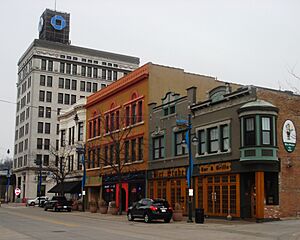
In the 1990s, Moline began to recover by redeveloping its riverfront. Deere & Company gave its old factory land to the city. The city built Vibrant Arena at The MARK (originally The Mark of the Quad-Cities) in 1993. This arena hosts concerts, sports, and other events. The Quad City Steamwheelers, an indoor football team, played here. It's also home to hockey teams like the Quad City Storm.
In the late 1990s, John Deere Commons was built. This area includes a hotel, restaurants, and the John Deere Pavilion, which shows the history of agriculture. The Commons attracts many visitors, boosting the downtown economy. Many old buildings were renovated, and new riverside homes and shops are being planned.
Moline still celebrates its diverse culture, with influences from French, German, Swedish, Belgian, Eastern European, and Mexican immigrants. Events like the Greek Cultural Festival and "Viva! Quad~Cities" show off this heritage. Downtown Moline also hosts major events like Taste of the Quad Cities and the Quad City Marathon.
Moline Today: Continued Growth and Development
Since the late 2000s, downtown Moline has seen more growth. A new nine-story building for Kone Elevator's American Headquarters opened in 2012. It has many solar panels, making it one of the largest solar power systems in Illinois. New apartments have also opened.
The I-74 Corridor Project has improved the I-74 Bridge over the Mississippi River. The new bridge, completed in 2021, has four lanes in each direction and an observation deck. In 2012, Western Illinois University-Quad Cities opened a new campus along the river. This campus has classrooms and meeting rooms, and it's the only college campus right on the Mississippi River. Phase II of the campus opened in 2014, doubling its size and adding more academic programs.
More projects are being planned as part of the city's "Moline Centre" downtown plan.
Exploring Moline's Location and Layout
The city of Moline is located on a bluff between the Mississippi River and Rock River in Rock Island County, Illinois. Many deep ravines cut through the city's higher areas, creating different neighborhoods. East Moline is to Moline's east, and Rock Island is to its west.
Moline is about 165 miles (266 km) west of Chicago and 164 miles (264 km) northwest of Springfield, Illinois. The Quad Cities area, including Moline, is the largest urban area along the Mississippi River between the Twin Cities to the north and St. Louis to the south. Four interstate highways serve the area: Interstate 74 (which goes through Moline), Interstate 280 (a ring road around the Quad Cities), Interstate 80 (which crosses the Mississippi a few miles northeast of Moline), and Interstate 88 (which starts on the eastern edge of the Quad Cities and goes towards Chicago).
In 2010, Moline covered about 16.66 square miles (43.1 km2), with most of it being land and a small part being water.
Moline's Unique Neighborhoods
The City of Moline has a Neighborhood Partnership Program that helps create neighborhood associations. These groups help residents with clean-up days, crime watch programs, and social activities.
Moline's downtown area, now called Moline Centre, is a historic part of the city. It includes City Hall and the old public library.
Other neighborhoods include Floreciente, Olde Towne, Uptown, Overlook, Karsten's Park, Wharton (home to Wharton Field House), Hamilton Heights, Wildwood, Prospect Park, Park Hill, Forest Hill, Highland, Villa Park, Green Acres, Molette, Rockview Estates, Homewood (home to the Playcrafter's Barn Theater), Heritage Park, Stewartville, Deerview, and Walton Hills.
Moline's Weather Patterns
Moline has a humid continental climate. This means it has hot, humid summers and cold, snowy winters. Rain and snow happen throughout the year, but more precipitation falls in the warmer months.
The average temperature ranges from about 22.6 °F (−5.2 °C) in January to 75.4 °F (24.1 °C) in July. On average, there are 23 days a year when the temperature reaches 90 °F (32 °C) or higher. About 43 days have temperatures at or below freezing, and 11 days have temperatures below 0 °F (−18 °C). The hottest temperature ever recorded was 111 °F (44 °C) on July 14, 1936, and the coldest was −33 °F (−36 °C) on January 30, 2019.
Snowfall averages about 31.6 inches (80 cm) per winter season. Measurable snow usually falls from November 21 to March 26.
| Climate data for Quad Cities (Quad City International Airport), 1981–2010 normals, extremes 1871–present | |||||||||||||
|---|---|---|---|---|---|---|---|---|---|---|---|---|---|
| Month | Jan | Feb | Mar | Apr | May | Jun | Jul | Aug | Sep | Oct | Nov | Dec | Year |
| Record high °F (°C) | 69 (21) |
74 (23) |
88 (31) |
93 (34) |
104 (40) |
104 (40) |
111 (44) |
106 (41) |
100 (38) |
95 (35) |
80 (27) |
71 (22) |
111 (44) |
| Mean daily maximum °F (°C) | 31.0 (−0.6) |
35.7 (2.1) |
48.8 (9.3) |
62.3 (16.8) |
72.9 (22.7) |
82.3 (27.9) |
85.8 (29.9) |
83.8 (28.8) |
76.8 (24.9) |
64.1 (17.8) |
49.2 (9.6) |
34.6 (1.4) |
60.6 (15.9) |
| Mean daily minimum °F (°C) | 14.3 (−9.8) |
18.3 (−7.6) |
29.4 (−1.4) |
40.5 (4.7) |
50.7 (10.4) |
60.7 (15.9) |
65.0 (18.3) |
63.2 (17.3) |
53.9 (12.2) |
42.4 (5.8) |
30.9 (−0.6) |
18.6 (−7.4) |
40.7 (4.8) |
| Record low °F (°C) | −27 (−33) |
−28 (−33) |
−19 (−28) |
7 (−14) |
25 (−4) |
39 (4) |
46 (8) |
40 (4) |
24 (−4) |
11 (−12) |
−10 (−23) |
−24 (−31) |
−28 (−33) |
| Average precipitation inches (mm) | 1.49 (38) |
1.60 (41) |
2.86 (73) |
3.59 (91) |
4.32 (110) |
4.49 (114) |
4.29 (109) |
4.52 (115) |
3.09 (78) |
2.97 (75) |
2.56 (65) |
2.18 (55) |
37.96 (964) |
| Average snowfall inches (cm) | 9.4 (24) |
6.8 (17) |
4.0 (10) |
0.9 (2.3) |
0 (0) |
0 (0) |
0 (0) |
0 (0) |
0 (0) |
0 (0) |
1.2 (3.0) |
9.3 (24) |
31.6 (80) |
| Average precipitation days (≥ 0.01 in) | 8.8 | 8.3 | 10.1 | 11.0 | 11.7 | 10.5 | 9.8 | 9.8 | 8.2 | 9.1 | 9.8 | 10.0 | 117.1 |
| Average snowy days (≥ 0.1 in) | 7.1 | 5.6 | 3.2 | 0.7 | 0 | 0 | 0 | 0 | 0 | 0 | 1.7 | 6.8 | 25.1 |
| Average relative humidity (%) | 69.9 | 69.8 | 68.3 | 64.3 | 64.9 | 65.8 | 70.5 | 73.3 | 72.8 | 68.1 | 71.3 | 74.0 | 69.4 |
| Mean monthly sunshine hours | 148.1 | 153.8 | 180.5 | 210.1 | 255.1 | 284.6 | 301.9 | 271.4 | 222.0 | 192.9 | 121.7 | 113.9 | 2,456 |
| Percent possible sunshine | 50 | 52 | 49 | 53 | 57 | 63 | 66 | 63 | 59 | 56 | 41 | 40 | 55 |
| Source: NOAA (relative humidity and sun 1961−1990) | |||||||||||||
Moline's Population and People
| Historical population | |||
|---|---|---|---|
| Census | Pop. | %± | |
| 1840 | 894 | — | |
| 1850 | 4,283 | 379.1% | |
| 1860 | 9,458 | 120.8% | |
| 1870 | 12,485 | 32.0% | |
| 1880 | 14,895 | 19.3% | |
| 1890 | 16,752 | 12.5% | |
| 1900 | 19,524 | 16.5% | |
| 1910 | 20,782 | 6.4% | |
| 1920 | 21,492 | 3.4% | |
| 1930 | 21,487 | 0.0% | |
| 1940 | 23,980 | 11.6% | |
| 1950 | 32,574 | 35.8% | |
| 1960 | 35,582 | 9.2% | |
| 1970 | 38,480 | 8.1% | |
| 1980 | 45,690 | 18.7% | |
| 1990 | 42,485 | −7.0% | |
| 2000 | 43,768 | 3.0% | |
| 2010 | 43,471 | −0.7% | |
| 2020 | 42,985 | −1.1% | |
| 2022 (est.) | 42,028 | −3.3% | |
| U.S. Decennial Census"/> | |||
| Race / Ethnicity (NH = Non-Hispanic) | Pop 2000 | Pop 2010 | Pop 2020 | % 2000 | % 2010 | % 2020 |
|---|---|---|---|---|---|---|
| White alone (NH) | 36,030 | 32,674 | 28,038 | 82.32% | 75.14% | 65.23% |
| Black or African American alone (NH) | 1,325 | 2,168 | 3,661 | 3.03% | 4.99% | 8.52% |
| Native American or Alaska Native alone (NH) | 56 | 72 | 75 | 0.13% | 0.17% | 0.17% |
| Asian alone (NH) | 601 | 1,023 | 1,276 | 1.37% | 2.35% | 2.97% |
| Pacific Islander alone (NH) | 9 | 7 | 13 | 0.02% | 0.02% | 0.03% |
| Other race alone (NH) | 40 | 23 | 132 | 0.09% | 0.05% | 0.31% |
| Mixed race or Multiracial (NH) | 495 | 752 | 1,759 | 1.13% | 1.73% | 4.09% |
| Hispanic or Latino (any race) | 5,212 | 6,764 | 8,031 | 11.91% | 15.56% | 18.68% |
| Total | 43,768 | 43,483 | 42,985 | 100.00% | 100.00% | 100.00% |
Moline's Demographics: A Look at the Numbers
According to the 2010 census, Moline had 43,977 people living in 19,032 households. About 28.8% of households had children under 18. The city's population was 86.2% White, 4.6% African American, 3.5% Asian, and 9.4% Hispanic or Latino (who can be of any race).
The median age in the city was 38 years old. About 24% of the population was under 18, and 15.4% was 65 or older.
The average income for a household in Moline was $47,970, and for a family it was $59,292. About 4.5% of the population lived below the poverty line.
Moline's Economy: Major Employers
Moline's economy is supported by several large employers. Here are the top ones from 2017:
| # | Employer | # of Employees |
|---|---|---|
| 1 | Deere & Company | 2,775 |
| 2 | Trinity Moline | 2,700 |
| 3 | Moline School District No. 40 | 855 |
| 4 | Western Illinois University - Quad Cities | 501 |
| 5 | Hy-Vee | 500 |
| 6 | Black Hawk College | 490 |
| 7 | Walmart Supercenter | 450 |
| 8 | City of Moline | 419 |
| 9 | United Healthcare | 360 |
| 10 | iWireless | 300 |
Arts and Culture in Moline
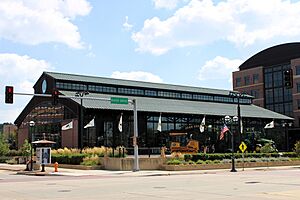
The John Deere Pavilion at John Deere Commons is a popular spot. It has exhibits about the history of farm equipment and displays many John Deere plows, tractors, and other machines. The LeClaire Hotel is the tallest building in Moline.
Moline has several official Historical Landmarks. These include the Moline Public Library in downtown Moline and the John Deere House at 1217 11th Avenue. You can find more details on the City of Moline Historic Landmarks website.
Sports and Recreation in Moline
Moline has a history with sports. The Tri-Cities Blackhawks, a professional basketball team that later became the Atlanta Hawks, played in Moline from 1946 to 1951 at Wharton Field House.
For many years, the Moline Plowboys minor league baseball team played at Browning Field. Famous future Major Leaguers like Peanuts Lowrey and Eddie Waitkus played for the Plowboys.
Today, Moline's Vibrant Arena at The MARK is home to the Quad City Steamwheelers, an indoor football team. The arena also hosts the Quad City Storm hockey team. The Quad Cities area also has the Quad City River Bandits, a Single A baseball team linked to the Kansas City Royals. They play their games in Davenport, Iowa.
Parks and Fun in Moline
The Moline Parks & Recreation Department manages 18 parks, covering 728 acres. They also oversee other recreational spots and cemeteries. Some notable parks include Riverside Park, which has the Riverside Family Aquatic Center and baseball/tennis courts. Prospect Park is home to the Quad City Music Guild.
The Ben Butterworth Parkway is a four-mile (6 km) scenic trail along the Mississippi River. You can find the Channel Cat Water Taxi and the Celebration Belle riverboat docked along the Parkway. The Moline Activity Center offers programs for adults who are retired or semi-retired.
Learning in Moline: Schools and Colleges
Moline is served by Moline School District No. 40, which teaches about 7,500 students. The district has twelve elementary schools, two middle schools (John Deere Middle School and Woodrow Wilson Middle School), and one high school (Moline High School).
For Catholic students, Seton Catholic School is available. It has the largest enrollment of any elementary and middle school in the Quad Cities. St. Paul's Lutheran School is a Christian Pre-K-8 grade school. Quad Cities Christian School also serves students from kindergarten through 12th grade.
Moline is home to two colleges. Black Hawk College is a community college with its main campus in Moline. Western Illinois University-Quad Cities is the only public four-year university in the Quad Cities area. Its campus is located along the Mississippi Riverfront.
Moline in the Media
The Quad Cities area has many media outlets. There are many radio stations and local TV channels like Fox, NBC, ABC, and CBS. There are also three newspapers. The Dispatch is Moline's traditional newspaper. The Rock Island Argus is owned by the same company. The Quad City Times, based in Davenport, also has an Illinois edition that is widely read.
The ABC TV station, WQAD-TV, has its studios in Moline's Prospect Park neighborhood.
Moline has even been mentioned in popular songs! It's in Creedence Clearwater Revival's song "It Came Out of the Sky" (1969) and Bob Seger's song "The Fire Down Below" (1976).
Getting Around Moline: Transportation
The Quad Cities International Airport is located on the southern edge of Moline. It's the third busiest airport in Illinois, after Chicago's O'Hare and Midway airports. It offers non-stop flights to eight different cities.
Quad Cities MetroLINK provides bus service throughout the Quad Cities, with its main hub in downtown Moline at Centre Station.
The I-74 Bridge is a major crossing over the Mississippi River. The first part of the bridge was built in 1935, and a second part was added in 1959. Both were replaced by new, larger spans in the 2020s to handle more traffic on Interstate 74.
Famous People from Moline
- Dorothy Sears Ainsworth, director of physical education at Smith College
- Kevin Anderson (tenor), opera singer
- Jack Barlow, country singer
- Bonnie Bartlett, television and film actress
- Louie Bellson, jazz drummer
- Vincent Hugo Bendix, inventor and industrialist
- Dave Blunts, hip-hop artist
- Virgil Bozeman, Illinois state representative and lawyer
- Ken Berry, actor, F Troop, Mayberry R.F.D.
- Grace Lincoln Hall Brosseau, President General of the Daughters of the American Revolution
- Don Carothers, football player
- Charles F. Carpentier, businessman and politician
- Donald D. Carpentier, businessman and politician
- Roy James Carver, industrialist and philanthropist
- Albert M. Crampton, Chief Justice of the Illinois Supreme Court
- Brad Cresswell, radio broadcaster and opera singer
- Doris Davenport, actress
- John Deere, tractor maker
- Acie Earl, power forward and center with several NBA teams
- Carl Ed, cartoonist (Harold Teen)
- John Getz, actor (The Fly and The Social Network)
- Warren Giles, executive in Baseball Hall of Fame
- Oscar Graham, baseball player
- Ron Hallstrom, offensive tackle with Green Bay Packers
- Warren E. Hearnes, Governor of Missouri 1965–73
- Robert R. Heider, Wisconsin State Assemblyman
- Donald A. Henss, Illinois state representative and lawyer
- Brad Hopkins, offensive tackle with the Tennessee Titans
- Corey Jahns, drummer with the Funk Brothers
- Jim Jamieson, golfer with the PGA Tour
- Robert White Johnson, songwriter
- Steve Kuberski, power forward and center with the Boston Celtics, Milwaukee Bucks, and Buffalo Braves
- Katherine Lanpher, journalist and podcaster
- Becky Lynch, WWE Athlete
- Dayton Moore, general manager of Kansas City Royals
- Gene Oliver, catcher, first baseman, outfielder for five Major League Baseball teams
- Aisha Praught-Leer, distance runner, 2-time Olympian
- Tom Railsback, US congressman (1967–1983)
- Heather Rattray, actress
- Ed Reimers, television announcer
- Wallace M. Rogerson, exercise leader
- Seth Rollins, WWE Athlete
- Sharm Scheuerman, Iowa basketball player and coach
- Marjorie Allen Seiffert, poet
- Dean Stone, All-Star pitcher for six Major League Baseball teams
- Don Sundquist, 47th governor of Tennessee
- Mildred Lund Tyson, composer
- Al Van Camp, first baseman and outfielder for the Cleveland Indians and Boston Red Sox
- Dwight Deere Wiman, Broadway producer
- Merton Yale Cady, architect and builder
See also
 In Spanish: Moline (Illinois) para niños
In Spanish: Moline (Illinois) para niños


